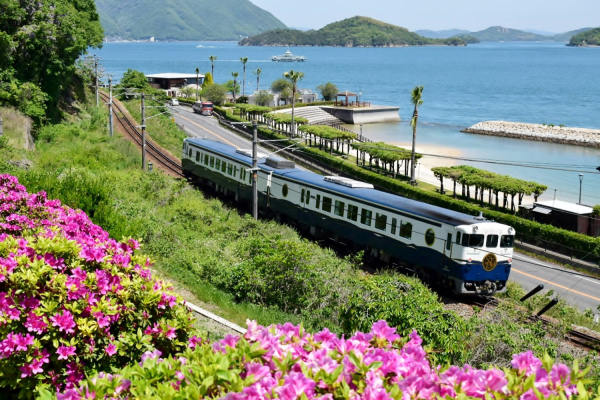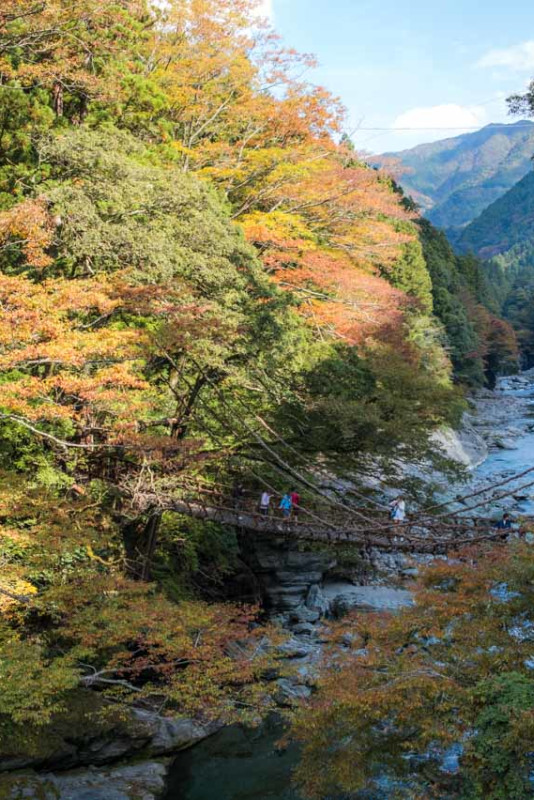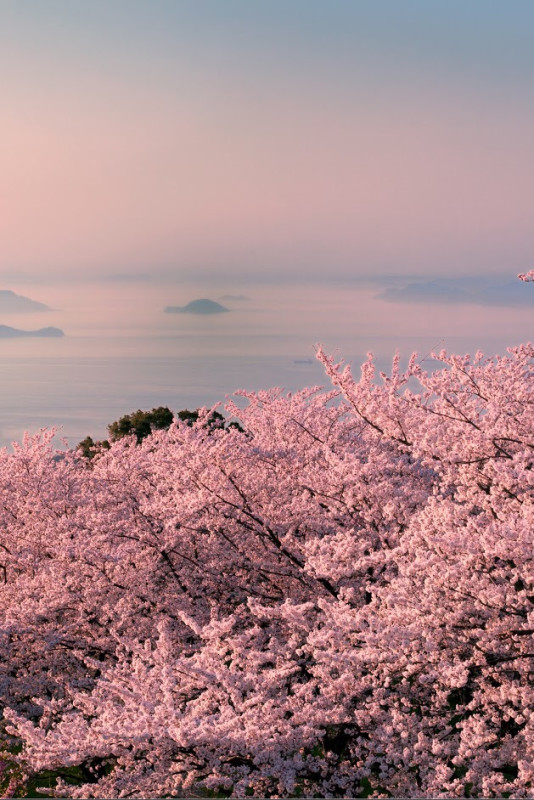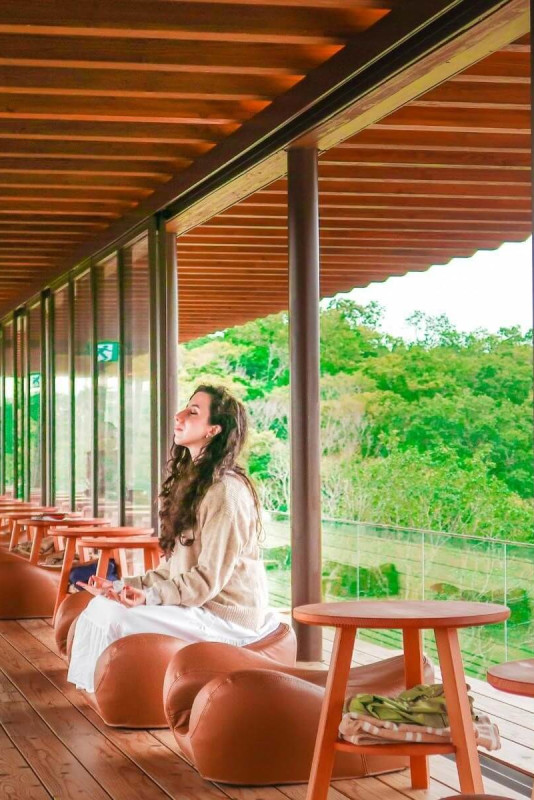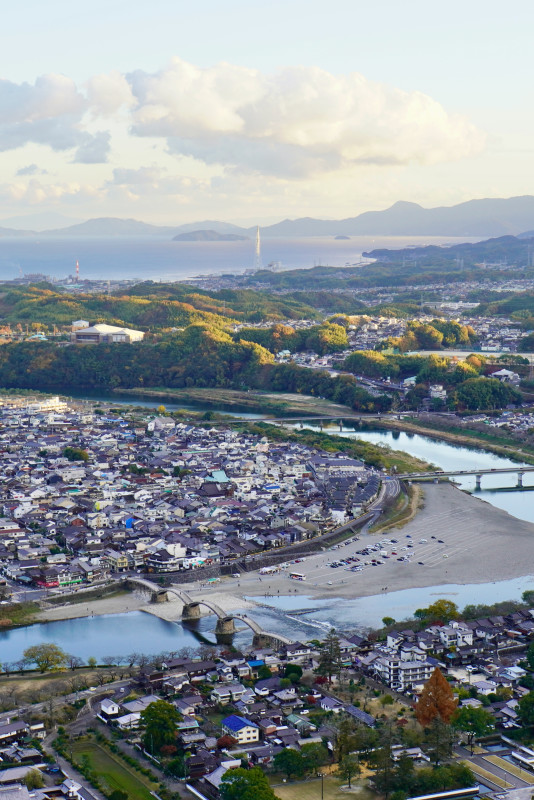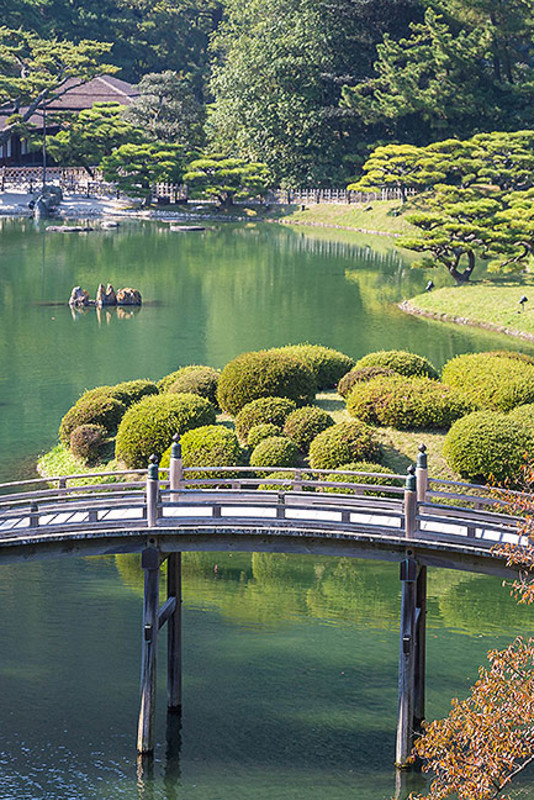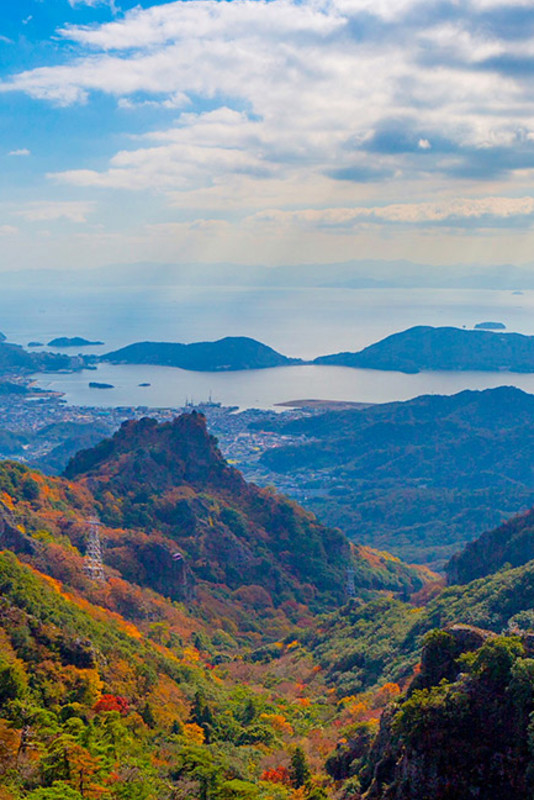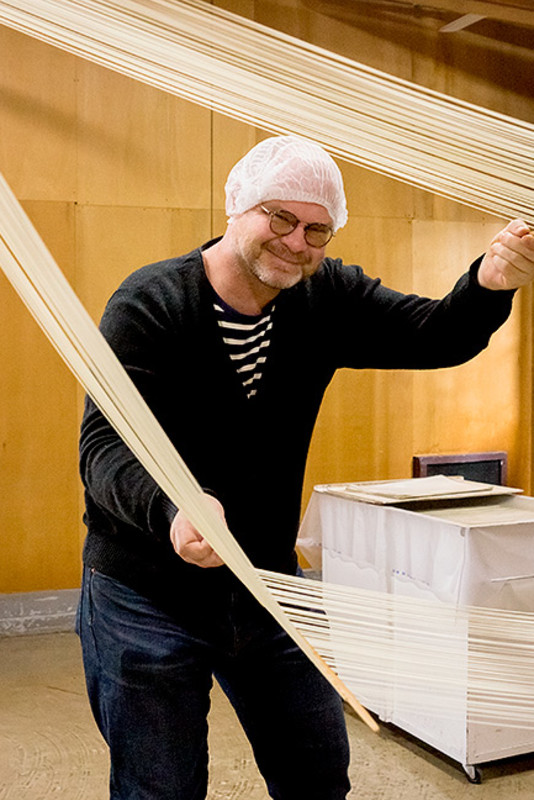Itineraries
Samurai Castles, Gardens, Townscapes and Culture in Eastern Setouchi

This is the perfect four-day itinerary for the traveler looking for deep insights into the feudal area of the samurai. You will visit two of Japan’s most unique castles, UNESCO World Heritage Site Himeji Castle and the hidden gem of Bitchu Matsuyama’s “Castle in the Sky”, as well as sublime gardens built for the pleasure of feudal lords. See the techniques behind that great symbol of samurai strength, the katana sword and walk the streets in which they carried them.
- Day 1
- Himeji, Bizen Osafune and Kurashiki
Travel: Osaka to Himeji
・Take the Shinkansen from Shin-Osaka Station to Himeji Station (Approx 30 minutes)
Experience the enchanting beauty and rich history of Himeji Castle
UNESCO World Heritage Site Himeji Castle stands as a testament to Japanese architectural brilliance. The sprawling castle grounds boast an impressive collection of over eighty meticulously designed buildings, the centerpiece of which is the Tenshu-gun, a complex comprising the donjon, keeps, and connecting structures, which showcase an intricate and highly advanced system of defense that dates to feudal times. The masterful construction and exquisite woodwork are awe inspiring, as are the elegant white plastered walls, from which its nickname, ‘White Heron Castle,’ comes.
In spring, over 1000 cherry trees come into bloom, creating breath-taking scenes viewable from both outside and inside the grounds. In the autumn the same trees turn fiery red around a week or so earlier than maple trees in the regions begin to change color.
Explore Japan’s rich garden heritage at Kokoen Garden
Immerse yourself in the refined elegance of the Edo Period (1603-1868) as you wander through the nine distinct gardens, each thoughtfully crafted to evoke a different facet of this bygone era, that make up Kokoen Garden. Unveiled in 1992, this splendid garden sits on the historic grounds of a former feudal lord's residence and has served as a backdrop for period TV dramas and movies. Take tea in the serene ambience of Soju-an tea house or treat yourself to a delectable lunch at renowned Kassui-ken where both the food and views provide a feast for the senses.
Nearby, Harima-no-Kuni Sosha Shrine has a history spanning over 1,400 years. In the year 1181, a total of 174 deities from various shrines in Harima Province were enshrined together and the shrine was a place of worship for generations of powerful samurai and is known as the protector shrine of Himeji Castle.
Travel: Himeji to Bizen Osafune Sword Museum
・Take the Shinkansen from Himeji Station to Okayama Station (Approx 20 minutes)
・Take a local train from Okayama to Osafune Station (Approx 30 minutes)
・Travel by taxi to Bizen Osafune Sword Museum (Approx 7 minutes).
Bizen Osafune Sword Museum
Of the 111 Japanese swords designated as National Treasures, 47 of them were made in Bizen. Easily accessible by river and blessed with a plentiful supply of high-quality iron sand and the abundant forests needed to make the large amounts of charcoal required for smelting, the area of Osafune in Bizen province developed into a renowned production site of quality swords in the medieval period. A visit to the Bizen Osafune Sword Museum is a must if you have a strong interest in the tradition and culture of sword making.
Located in Japan’s sword Mecca, as well as exceptional displays, artisans also work onsite, each contributing to one of the intricate processes involved in the crafting of a finished sword. Most spectacular of all, it is possible to see the hammering of the tamahagane steel from which these works of art are wrought. Held on the second Sunday of each month, make sure to book your spot and see this live traditional smithing demonstration up close.
The museum also holds knife-making workshops. Making your own “kogatana” (small knife) involves multiple visits spread over several weeks, but one-day paper knife making workshops can be scheduled through discussion with the museum. All workshops require reservations at least two weeks in advance. Check the museum website for the latest details.
URL: https://www.city.setouchi.lg.jp/site/token/
Travel: Bizen Osafune Sword Museum to Kurashiki
・Take the local train from Osafune Station to Kurashiki Station (Approx 1 hour)
Take an evening stroll around the Kurashiki Bikan Historical Quarter
Kurashiki prospered as a political center and trade hub after coming under the direct control of the Tokugawa Shogunate in 1642. Kurashiki’s fortune continued during the late 19th century and early 20th century, this time led by the textile industry. As the town escaped relatively unscathed in WWII, the mix of traditional Japanese and Western-style warehouses and mansions built along the Kurashiki River still remain. In the Bikan Historical District, you can take a walk through history, from the time of the samurai to Japan’s emergence as an industrial powerhouse.
As night descends, and the streets are illuminated and the quarter takes on a serene ambiance.
Accommodation: Ryokan Kurashiki
Ryokan Kurashiki, overlooking the canal that runs through the heart of Kurashiki’s historical district, is in one of the most picturesque locations in the district and is considered the best traditional Japanese inn experience in the area. Housed in a former sugar warehouse, all Ryokan Kurashiki’s eight rooms have a traditional architectural aesthetic with stylish accents and modern comforts such as low profile western beds. The Okuzashiki suite, tucked away within the depths of the ryokan, feels like staying in your own private villa. Exquisite seasonal kaiseki dinners, featuring the abundant produce of the Setouchi region, and beautifully presented breakfasts are a highlight. Use of a private onsen is also available by reservation.
URL: http://www.ryokan-kurashiki.jp/en/
- Day 2
- Kurashiki, Bitchu Takahashi and Fukiya
The Kurashiki Bikan Historical Quarter by day
Kurashiki’s historical quarter is not only expertly preserved, but also quite lively. A wide variety of shops, cafes and eateries, from traditional to trendy, are based in the warehouses, and it is a pleasure to wander around the town. Traditional boat tours along the Kurashiki Canal that flows through the district, allow you to admire the town's charm from a different perspective. Several places rent kimono and yukata for visitors to fully embrace the historical vibe.
Museum and culture lovers are well catered for within this compact, walkable area. Prime among Kurashiki’s museums is the Ohara Museum of Art which has an impressive collection of internationally acclaimed masterpieces. The Kurashiki Museum of Folkcraft and Kurashiki Archaeological Museum are appropriately housed in 200-year-old rice granaries. Ivy Square, a red brick facility on the site of a former cotton mill, offers a variety of workshop activities, including Bizen-yaki pottery, which is one of Japan's six ancient pottery styles.
There are many places to eat around Kurashiki’s historical district, but, if you are looking for a refreshingly sweet treat, one in particular deserves a special mention. Kurashiki Momoko is very popular for its gorgeous and tasty parfaits, desserts and cakes featuring seasonal fruits, including many that are locally grown in Okayama Prefecture. Okayama’s mild climate and technical skill of its farmers have earned it the nickname of the “Kingdom of Fruit” and Kursashiki Momoko is a great place to sample some. There are four outlets to choose from, but the original Sohonten has an impressive collection of French Art Nouveau glassware by Émile Gallé on display.
Travel: Kurashiki to Bitchu Takahashi
・Take the train from Kurashiki to Bitchu Takahashi tation (Approx 25−40 minutes)
・Approx 11 minutes by taxi to Fuigo-toge Pass Parking Lot (for Bitchu Matsuyama Castle)
・Approx 16 minutes by taxi to Bitchu Matsuyama Castle Observatory
Bitchu Matsuyama Castle
One of several places referred to as the “Machu Picchu of Japan”, perched on a mountaintop 430m above sea level, Bitchu Matsuyama Castle is indeed found in one of the most spectacular locations of any Japanese castle. While Himeji Caste is the most famous of Japan’s twelve remaining original castles, Bitchu Mastuyama is not only the only mountaintop fortress among them, but, originally built in 1240, it is also the oldest. You will be transported back in time as you ascend to its lofty heights, a 20-minute walk from the nearest parking lot. During November and December, the castle is often shrouded in a sea of clouds, an atmospheric sight best seen from the observation deck on another mountain nearby.
Bitchu Takahashi Samurai Houses
Walk in the footsteps of the samurai in Takashi old town and visit two well preserved former samurai residences that date from the Edo era (1603-1868). In the Haibara House and Orii House varied architectural aesthetics and architecture of the period are on display as well as the enduring nature of Japanese craftsmanship. As you explore these buildings, admire the tranquil beauty of the surrounding gardens, complete with elegant stepping stones and serene ponds.
Raikyuji Temple
This Zen temple once served as the residence of Kobori Enshu (1579-1647), who, as well as a poet and painter, was a prolific garden designer and instructed Tokugawa Shoguns in the art of the tea ceremony. The dry garden here is an example of his artistry.
In the spring, beautiful hina doll displays are set up in historial merchant houses on Honmachi Machiya Street and cherry blossoms burst into bloom all along the Koyagawa river.
Travel: Bitchu Takahashi to Fukiya
Take the bus from Takahashi to Fukiya Furusato Village (Approx 1 hour by bus)
Fukiya Furusato Village
Fukiya Furusato Village is a quaint, out-of-way town once flourished thanks to copper mining and is notable for the vivid red bengara pigment made from oxidized iron. Copper-colored houses with signature iron-red roof tiles line the streets as they have since the town’s heyday over a century ago. The beautiful landscape created by the predecessors remains unchanged. The mansions may still be used as homes or for commercial use, such as tea shops, grocery stores, and restaurants, adding some elements to the quaint streets, and still retaining traditions, so that people who visit can feel Local atmosphere. With a reservation, you can try your hand at pottery making at the Bengara Ceramics Museum and bengara-dyed fabrics available for sale in the little shops.
Travel: Fukiya to Okayama
Take the bus back to Bitchu Takahashi Station (Approx 1 hour)
Take the train from Bitchu Takahashi Station to Okayama (Approx 25-40 minutes)
Okayama Kakushi Sushi: A local speciality with a fascinating history
This traditional dish emerged in response to an ordinance issued by a local lord restricting meals to "one soup and one side dish." To circumvent the decree, an abundant assortment of fish and seasonal vegetables were heaped atop sushi rice, to create an opulent dish that could still technically be described as a single side dish. Not only visually stunning, kakushi sushi also has a delectable flavor profile. Each bite is a symphony of textures and tastes, as the freshness of the fish and the crispness of the vegetables mingle with the subtle tang of the vinegar-infused rice.
Japanese Restaurant Kibizen in Okayama maintains the tradition and offers authentic kakushi sushi. On first appearance, the wooden box appears to be just a layer of rice and finely shredded egg. However, flip the box upside down and you will reveal a hidden layer of delicious seasonal sashimi. The traditional dipping sauce made from pickled plums boiled in sake and dashi adds another layer of authenticity to the dish.
Chat with local people over local sake
End your day of history and culture chatting with locals over local sake. Okayama Sake Bar Sakabayashi is only minutes from the ANA hotel and serves over 200 locally produced sake from around Okayama prefecture.
Accommodation: ANA Crowne Plaza Okayama
Just a 1-minute walk from JR Okayama Station, the only international hotel in the city, ANA Crowne Plaza Okayama offers exceptional service and convenience. The rooms are of simple, modern design and are the perfect place to relax after a full day of cultural exploration and to make sure you are refreshed and ready to explore the city the next day.
If you visit during summer or autumn, be sure to check the schedule for the annual illumination of Okayama Castle’s grounds and Korakuen Garden. The gardens are open later than usual and look very pretty.
URL: https://www.crowneplaza.com/hotels/jp/ja/okayama/okjja/hoteldetail/
- Day 3
- Okayama and Takamatsu
Okayama Castle and Korakuen Garden
The majestic black facade of Okayama Castle, from which it earned its moniker, 'Crow Castle', provides a striking contrast to the pristine white walls of Himeji Castle. Positioned gracefully alongside the flowing Asahi River, Okayama Castle invites you to relax and absorb the breath-taking views of the castle itself and adjacent Korakuen Garden.
In the castle, explore distinctive architectural features of Japanese castle design, discover workshops dedicated to the region’s Bizen-yaki pottery and don traditional princess or feudal lord attire for a memorable photoshoot.
Korakuen Garden, ranked among the top three in the country, is a harmonious fusion of meticulously manicured landscapes, tranquil ponds, and enchanting traditional architecture. Immerse yourself in the timeless beauty of sculptured landscapes, traditional tea houses, and vibrant koi ponds—a symbol of wealth and power in Japanese culture. Within the garden you can experience several Japanese traditions. Any time of the year you can try a Japanese tea ceremony in one of the tea houses within the garden. At certain times of the year, some of the formal buildings host tea ceremonies where masters host and teach you the art of tea.
Learn about the rich cultural heritage of the samurai at Hayashibara Museum of Art
Located within the grounds of Okayama Castle, the Hayashibara Museum of Art’s collection consists of around 10,000 artifacts, including swords, armor, Noh costumes and masks, furniture, paintings, calligraphy, lacquer work and pottery, of which approximately 40% are showcased at any given time. The building itself is also impressive, the Kunio Maekawa design seamlessly merging tradition with modern architectural brilliance.
Travel: Okayama to Takamatsu
・Take the Marine Liner Limited Express Train from Okayama to Takamatsu across the Great Seto Bridge (Approx 1 hour)
Accommodation: Anabuki Tei
Experience the enchantment of Anabuki Tei This two-floor living space, adorned with European furniture and exuding warmth and craftsmanship in every detail, even has its own castle turret, just like those at the nearby Takamatsu Castle. Enjoy the tranquillity of its Japanese garden and avail yourself of the range of unique services, from bonsai workshops to sweets-making classes. Whether you are traveling with family or a group of friends, this expansive retreat can comfortably accommodate you. Anabuki Tei has a well-equipped kitchen with everything you might need to cook for yourself, or you can employ the service of the traveling chef service to savor delectable dishes made with seasonal ingredients.
URL: https://www.anabukitei.jp/en/
- Day 4
- Takamatsu and Marugame
Ritsurin Garden
Enjoy traditional Japanese tea and a tranquil boat ride in Takamatsu’s world-renowned 400-year-old Ritsurin Garden. Famous for its picture postcard views and hundreds of well-manicured pine trees, Ritsurin Garden is designated as a Special Place of Scenic Beauty and received a glowing three-star review in the Michelin Green Guide Japan.
Bonsai at Takumikumo in Kinashi Town
After wandering among the pine trees of Ritsurin Garden, check out some in miniature in the nearby town of Kinashi. Takamatsu is said to produce 80% of bonsai pines and Kinashi Town is the home of Takamatsu Bonsai. Nakanishi Chinshoen’s fifth generation-owner Yoichi Nakanishi is keen to help visitors interact with bonsai to learn more about this age-old craft. At Takumikumo, visitors can explore a forest of exquisite bonsai trees and leave with a newfound understanding of the philosophy, skill and patience needed to create these living masterpieces.
2.5 hour tour of the gardens and nursery, led by a bonsai master, followed by your choice of cultural experience (choose from creating your own bonsai moss ball, trying kintsugi golden joinery or making wagashi sweets, lacquerware or uchiwa fans) are available with 2 weeks advance notice.
Beautifully prepared lunches and dinners, using seasonal ingredients and served on artisanal tableware can also be arranged for groups of 4 people or more (Halal, vegetarian, vegan options also available) with 2 weeks advance notice.
URL: https://v.takumikumo.com
Travel: Takamatsu to Marugame
・Take the local train from Takamatsu Station to Marugame Station(Approx 30 minutes
・Marugame Castle is approximately 15 minutes walk or 5 minutes by bus from Marugame Station
Marugame Castle
Marugame Castle is the last castle on this itinerary and it has the smallest keep of the twelve throughout Japan that have survived since the feudal era. The original keep, built at the turn of the 17th century, was destroyed as a result of the Shogun's "one province, one castle" rule and the current building dates from 1660.
Marugame is a hilltop castle and the steep walk through the impressive defensive walls is rewarded with panoramic views of the surrounding area and the Seto Inland Sea. Marugame Castle and Kameyama Park in which it now stands is particularly pretty during the spring cherry blossom season.
Marugame Uchiwa Museum
A fun museum dedicated to that symbol of the Japanese summer, the handheld non-folding fan, known as uchiwa. Crafted with bamboo frames, renowned for their durability and flexibility, these fans continue to be much used today, and Marugame is said to be the producer of around 90% of all the uchiwa in Japan. Discover a captivating range of bamboo fans in all shapes, sizes, and designs. Watch artisans demonstrate their skills as they transform each fan to a little work of art and try your hand at making one to take home.
Nakazu Banshoen Garden
Nakazu Banshoen is a pretty Japanese garden built for the lord of Marugame in the 17th century. Take in the views from the vermillion Yogetsubashi Bridge and feed the koi carp that swim below. Admire the sprawling 15-meter wide canopy of an umbrella-shaped pine tree, said to be modeled on Mt Fuji, and hundreds of years old. Follow the enchanting passage adorned with over 100 torii gates, leading to a branch of Kyoto’s famous Fushimi Inari Shrine.
Within the garden's grounds, there is also an art gallery with works by painters of the Barbizon School, including Millet and Collot, and a pottery gallery exhibiting earthenware, ceramics, and glassware dating from 2500 BC to the 13th century AD, unearthed from present-day Iran and Iraq.
Sanuki Udon
If you haven't already, you simply must try Sanuki Udon noodles before you leave Kagawa Prefecture. The preparation of this simple dish has been turned into a fine art and it can be said that these soft and delightfully chewy noodles are almost a way of life here. Little eateries selling them, both chilled with a dipping sauce or in a hot broth with toppings, are to be found everywhere, many of them self service. Locals eat their udon unbelievably fast, so if you wish to savor the experience, it is advised to avoid the busy 12pm-1pm lunch hour if possible.
































































































